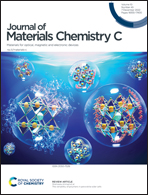A considerable improvement of long-persistent luminescence in LiLuSiO4:Pr3+ phosphors by Sm3+ co-doping for optical tagging applications†
Abstract
Solar-blind ultraviolet-C (UVC; 200–280 nm) luminescent materials have exhibited great potential for wide applications in photomedicine and photochemistry due to the unique spectral features of UVC light. However, it is still a challenging work to develop persistent phosphors emitting in the UVC spectral region owing to the lack of suitable host materials and emitting centers. Herein, we report a series of LiLuSiO4:Pr3+,Sm3+ UVC persistent phosphors that can be charged by a 254 nm UV lamp or a high-energy X-ray beam giving rise to long-lasting UVC light emission peaking at 280 nm. More importantly, a considerable enhancement of UVC afterglow intensity and decay time has been achieved by Sm3+ co-doping because the Sm3+ ions can act as effective electron traps, which has been verified by the spectroscopic investigations and first-principles calculations. On top of this, narrowband ultraviolet-B (NB-UVB) persistent luminescence with a line emission at 313 nm has also been realized by introducing Gd3+ into LiLuSiO4:Pr3+,Sm3+ persistent phosphors based on persistent energy transfer from Pr3+ to Gd3+. Considering that the UVC and NB-UVB persistent luminescence can fully avoid severe interference from ambient light, the as-prepared LiLuSiO4:Pr3+,Sm3+ and Li(Lu,Gd)SiO4:Pr3+,Sm3+ persistent phosphors can find promising applications as invisible identification taggants in a bright environment.



 Please wait while we load your content...
Please wait while we load your content...